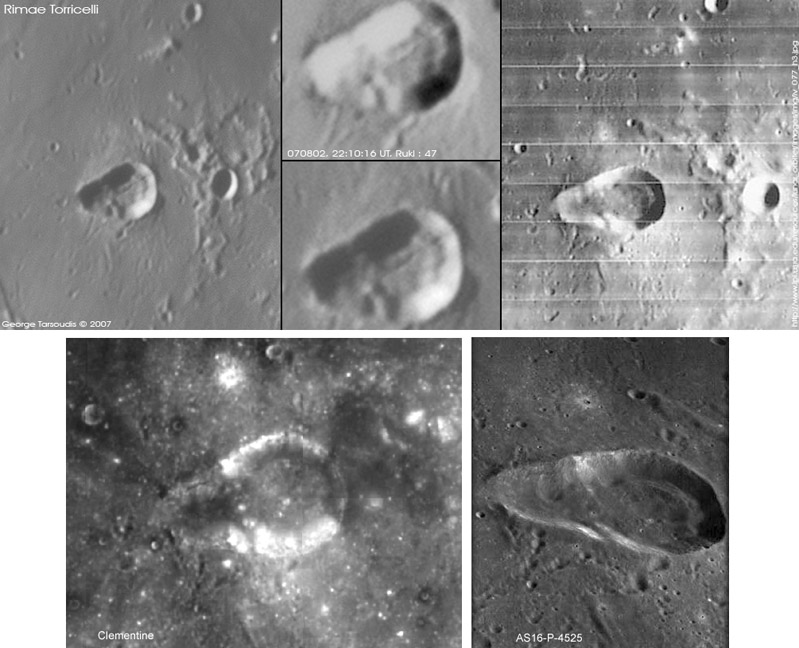|
|
| (5 intermediate revisions by the same user not shown) |
| Line 1: |
Line 1: |
| | __NOTOC__ | | __NOTOC__ |
| | =A Non-Event in Torriceli?= | | =A Non-Event in Torriceli?= |
| | + | <!-- Start of content --> |
| | + | <div class="post" id="post-1309"> |
| | | | |
| − |
| + | <div class="storycontent"> |
| − | <div class="post" id="post-1309">
| + | <p>[[File:Torricelli_LPOD.jpg|Torricelli_LPOD.jpg]]<br /> |
| − |
| |
| − | <div class="storycontent">
| |
| − | <p>[[File:Torricelli_LPOD.jpg|Torricelli_LPOD.jpg]]<br />
| |
| | <em>images by [mailto:g.tarsoudis@freemail.gr George Tarsoudis], Alexandroupolis, Greece, and Apollo and Clementine</em></p> | | <em>images by [mailto:g.tarsoudis@freemail.gr George Tarsoudis], Alexandroupolis, Greece, and Apollo and Clementine</em></p> |
| − | <p>George has imaged a feature in Torricelli that does not show up in other, higher resolution images. His image of August 2 shows an approximately linear feature, with a narrow shadow and opposite bright edge, that extends across the crater floor and up the eastern wall. George compares his view with a Lunar Orbiter IV photo of similar angle but opposite lighting that gives no hint of the linear marking. I have added the high resolultion Apollo Panoramic Camera image (below right) and a very high Sun Clementine view (below left) that also fail to show the feature. So either it has formed since the Apollo and Clementine images, or it is a defect in George’s image, or a trick of lighting. The latter two possibilities are much more likely than the first. Observations that may indicate an origin as an artifact are the feature’s straightness and its extension up the crater wall without changing its angle. The shadow and piece of bright lip match the lighting, suggest it is a real feature, made visible by just the illumination that George captured. In fact, another [http://the-moon.wikispaces.com/Torricelli image] with very similar lighting shows a small shadow on the floor and a dark marking on the wall. Now, looking closely at the Clementine image a dark band is seen on the crater wall. So, my conclusion is that this is not a new feature, nor a defect, but an enhancement of subtle features by perfect lighting.</p> | + | <p>George has imaged a feature in Torricelli that does not show up in other, higher resolution images. His image of August 2 shows an approximately linear feature, with a narrow shadow and opposite bright edge, that extends across the crater floor and up the eastern wall. George compares his view with a Lunar Orbiter IV photo of similar angle but opposite lighting that gives no hint of the linear marking. I have added the high resolultion Apollo Panoramic Camera image (below right) and a very high Sun Clementine view (below left) that also fail to show the feature. So either it has formed since the Apollo and Clementine images, or it is a defect in George’s image, or a trick of lighting. The latter two possibilities are much more likely than the first. Observations that may indicate an origin as an artifact are the feature’s straightness and its extension up the crater wall without changing its angle. The shadow and piece of bright lip match the lighting, suggest it is a real feature, made visible by just the illumination that George captured. In fact, another [https://the-moon.us/wiki/Torricelli image] with very similar lighting shows a small shadow on the floor and a dark marking on the wall. Now, looking closely at the Clementine image a dark band is seen on the crater wall. So, my conclusion is that this is not a new feature, nor a defect, but an enhancement of subtle features by perfect lighting.</p> |
| | <p>[mailto:tychocrater@yahoo.com Chuck Wood]</p> | | <p>[mailto:tychocrater@yahoo.com Chuck Wood]</p> |
| | <p><strong>Technical Details:</strong><br /> | | <p><strong>Technical Details:</strong><br /> |
| Line 15: |
Line 14: |
| | Rükl plate 48<br /> | | Rükl plate 48<br /> |
| | [http://www.flickr.com/photos/80161946@N00/?saved=1 George’s website]</p> | | [http://www.flickr.com/photos/80161946@N00/?saved=1 George’s website]</p> |
| − | <p align="center"> | + | <p><b>Yesterday's LPOD:</b> [[August 10, 2007|Feastland]] </p> |
| − | <em>Now you can support LPOD when you buy ANY book from Amazon thru [[LPOD]]</em></p> | + | <p><b>Tomorrow's LPOD:</b> [[August 12, 2007|A Radial Section of Debris]] </p> |
| − | </div>
| + | <!-- Removed reference to store page 2 --> |
| − |
| + | </div> |
| − | | + | <!-- End of content --> |
| − | ---- | + | {{wiki/ArticleFooter}} |
| − | ===COMMENTS?===
| |
| − | Click on this icon [[image:PostIcon.jpg]] at the upper right to post a comment.
| |




